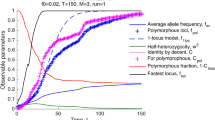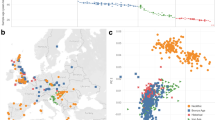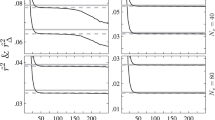Summary
The effect of viability selection at linked loci on segregation ratios at a specified studied locus is analysed in this, paper for the crosses of a heterozygote to a homozygote and of two heterozygotes. Both autosomal and sex-linked loci are treated. The analysis indicates that it would be unusual for the change in frequency of a given allele at the studied locus to be distorted by as much as one per cent by the combined effects (assumed to be additive) of selection at all linked loci. This result encourages the use of pedigree analysis in tests of the null hypothesis of selective neutrality of the genotypes at a particular locus since the inevitable cases where selection at linked loci does lead to incorrect rejection of the null hypothesis should be relatively few.
Similar content being viewed by others
Article PDF
References
Asmussen, M A, and Clegg, M T. 1981. Dynamics of the linkage disequilibrium function under models of gene frequency hitch-hiking. Genetics, 99, 337–356.
Colgan, D J. 1981. The relative viabilities of alternative human genotypes. Human Heredity, 31, 172–179.
Crow, J F, and Kimura, M. 1970. An Introduction to Population Genetics Theory. Harper and Row, New York.
Haldane, J B S. 1962. Evidence for heterosis in woodlice. J Genet, 58, 39–45.
Lamb, B C, and Helmi, S. 1982. The extent to which gene conversion can change allele frequencies in populations. Genet Res, 39, 199–217.
Sandler, L, and Novitski, E. 1957. Meiotic drive as an evolutionary force. Amer Nat, 91, 105–110.
Sing, C F, Shreffler, D C, Neel, J V, and Napier, J A. 1971. Studies on genetic selection in a completely ascertained Caucasian population. II. Family analyses of eleven blood group systems. Am J Hum Genet, 23, 164–198.
Sved, J A. 1968. The stability of linked systems of loci with a small population size. Genetics, 59, 543–563.
Author information
Authors and Affiliations
Rights and permissions
About this article
Cite this article
Colgan, D. The effects of linked loci on estimates of relative viability derived from pedigree analysis. Heredity 53, 69–77 (1984). https://doi.org/10.1038/hdy.1984.63
Received:
Issue date:
DOI: https://doi.org/10.1038/hdy.1984.63



